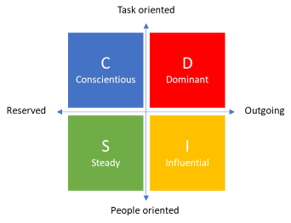If you are new to the idea of Team Praxis, please read our introduction to the concept before using the table below to improve your communications with team members, stakeholders and anyone else involved in your project, programme or portfolio.
The goals of benefits management are to:
- define benefits and dis-benefits of the proposed work;
- establish measurement mechanisms;
- implement any change needed in order to realise benefits;
- measure improvement and compare to the business case.
When implementing these goals people with different character traits would perceive benefits management plans and techniques in different ways.
 Concientious behaviour would typically propose or want to see: Concientious behaviour would typically propose or want to see:
-
an explanation of what benefits management is aiming to achieve; -
a consistent and systematic approach to planning, quantifying, valuing and realising benefits; -
a long term commitment to the monitoring of benefits realisation; -
tangible and detailed financial benefits which are measureable and can be demonstrably realised; -
consideration of benefits and lessons from previous projects; -
clear allocation of costs to benefits; -
the use of techniques for valuing benefits that are quantitative and facilitate decisions; -
a robust plan that links outputs to the changes that are necessary to realise the benefits. Someone exhibiting concientious behaviour would typically be perceived as: |  Dominant behaviour would typically propose or want to see: Dominant behaviour would typically propose or want to see:
-
action taken quickly to identify benefits that help justify the business case; -
a pragmatic view of the achievability of benefits realisation; -
that they have maximum freedom to take action as they believe necessary; -
resources being identified and committed to benefits management; -
the use of techniques that identify short term benefits; -
lessons from previous projects taken into account and planned actions to implement them; -
quantitative valuations that allow speedy decision making; -
timely monitoring and control to ensure that people are being held to account for realisation of benefits. Someone exhibiting dominant behaviour would typically be perceived as: |
 Steady behaviour would typically propose or want to see: Steady behaviour would typically propose or want to see:
-
key individuals engaged in the procedure and given the opportunity to input; -
equal consideration to intangible and non-financial benefits; -
a clear understanding of the impact on people; -
that planning, valuing and realisation engages as many stakeholder groups as possible; -
consideration of dis-benefits where there is a negative impact on people; -
caution regarding how quickly benefits can be realised; -
benefits and dis-benefits that are people centric (often intangible and non-financial); -
the use of qualitative techniques for valuing benefits; -
an approach agreed by all parties with clear responsibilities that are fairly allocated across the team. Someone exhibiting steady behaviour would typically be perceived as: -
being empathetic to the impact of the proposed change on people; -
a leader who wishes to ensure that there is adequate change management resource and effort; -
focusing on the attitudes and behaviours of those impacted versus the financial benefits of the project; -
focusing on dis-benefits as well as benefits. |  Influential behaviour would typically propose or want to see: Influential behaviour would typically propose or want to see:
-
clear communication on the importance of benefits management in improving team motivation and thereby performance; -
short term responsibilities for benefits management are identified; -
encourage early interaction within the team and with stakeholders as part of identifying potential benefits; -
a broad view of benefits in particular intangible and non-financial benefits; -
a broad range of benefits identified which can then be pared down; -
less focus on dis-benefits where they don’t consider them significant; -
the adoption and use of qualitative techniques for valuing benefits; -
a flexible and simple means of monitoring actions. Someone exhibiting influential behaviour would typically be perceived as: -
over-estimating benefits, in particular intangible and non-financial benefits; -
being overly optimistic regarding the ease with which benefits can be realised. |
Thanks to Donnie MacNicol of Team Animation for providing this page.


 Concientious behaviour would typically propose or want to see:
Concientious behaviour would typically propose or want to see: Dominant behaviour would typically propose or want to see:
Dominant behaviour would typically propose or want to see:  Steady behaviour would typically propose or want to see:
Steady behaviour would typically propose or want to see: Influential behaviour would typically propose or want to see:
Influential behaviour would typically propose or want to see:



